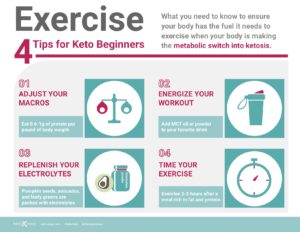As your body is making the metabolic switch into a state of ketosis (burning body fat for energy) on a keto diet, it’s best to take it easy in the gym. You may feel fatigued from the short-lived side effects of changing your energy source from carbohydrates (glucose) to ketones (i.e. an alternative fuel source created from a very low-carb, high-fat diet). Listen to your body. It takes time to start fat-burning and become fat adapted, so be patient. Your body is going through a lot of changes during your first month on a high-fat, low-carb diet.
After about the first week of being in ketosis (and hopefully getting through the keto flu), some people feel they can get back to their old exercise routine. Don’t worry if you’re not; you can stay in keto and even experience fat loss without exercising. Regardless, by your fourth week, you’ll for sure feel energized and ready to reinstate old exercise habits or initiate new ones, whether it’s high-intensity, moderate-intensity, low-intensity, high-intensity interval training (hiit), weight lifting to build muscle, aerobic or cardio activities, or other types of exercise.
In fact, a targeted ketogenic diet is great for high-intensity workouts, muscle growth (building muscle mass), especially if you know your metabolic edge.
Today we’ll tell you what you need to know to ensure your body has the fuel it needs to hit the gym, pool, TRX class, or yoga mat, whether your desire is weight loss, muscle building, or just general health benefits.
Confirm Your Macros
The key to energized physical activity on the ketogenic diet is making sure you are eating enough protein, fat, and calories. In fact, you’ll want to eat a bit more protein if you exercise regularly and vigorously.
The amount you need depends on the type of activity you’re doing, the duration, frequency, and level of exertion. But a general recommended for non-professional athletes is a total of 0.6 to 1 gram of protein per pound that you weigh per day. (A “non-professional athlete” is considered to be anyone who exercises three-plus days per week with an elevated heart rate for 30-plus minutes.)
To know the exact right amount you should add, it’s a good idea to reconfigure your macronutrients, factoring your exercise into the equation, with a calculator like the MyMojoMacros; it helps you figure out your body’s needs based on many factors, including your activity level.
Energy Load
Having a pre-workout meal or high-fat drink will help give you energy to complete any athletic performance, including high-intensity exercise. Some people like to mix a flavored MCT powder with unsweetened almond milk, while others enjoy a bulletproof coffee, low-protein-high fat shake, or even some spinach or a hard-boiled egg.
Hydrate
Make sure you’re adequately hydrated and keeping up on your electrolytes as well. Remember, you can do this by consuming foods high in magnesium, potassium, and sodium (think pumpkin seeds, avocados, leafy greens, or electrolyte powders.
Time Your Exercise Right
It’s important to time your nutrition right for your workouts. While some enjoy working out in a fasted state, others prefer to eat prior to exercise. You’ll need to try both options to see what works best for you. If you want to eat before exercise, try timing your meal to no more than two to three before your exercise and include lots of good fats and some protein. If you prefer to eat after a workout, eat within two hours after; you can still have a bit of extra protein during this time frame without affecting ketosis (as always, test your ketone levels to find your sweet spot).
Watch this video by Thomas DeLauer, celebrity health and fitness coach, explaining how testing your ketones before and after a workout can help you find your metabolic edge.

Mojo On!
Now you know–there’s no need to be afraid to crush it in the gym. The ketogenic diet won’t hold you back from aerobic exercise, strength training, sprinting, or any other physical performance! In fact, if done properly your keto status can help you reach new fitness and energy levels.



